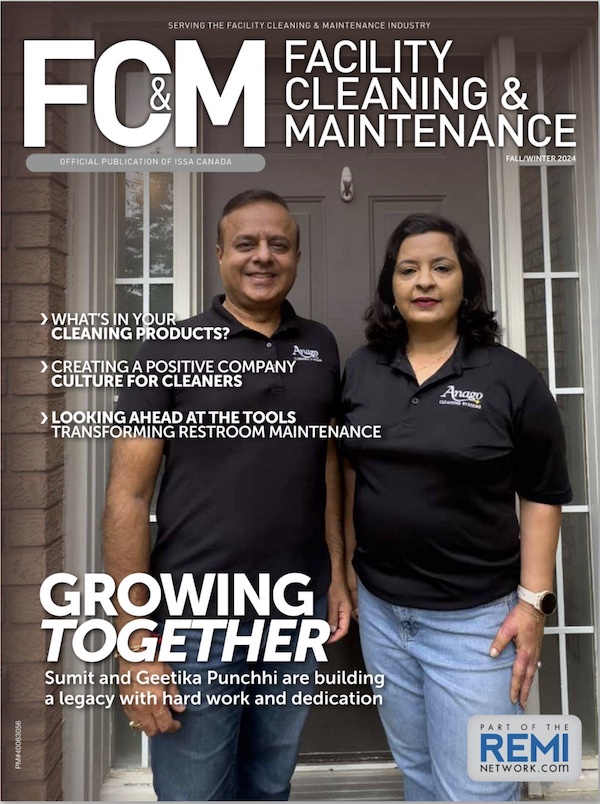Today’s facility managers are under mounting pressure to do more with less. Supply chain challenges, labour shortages, and Canadians’ increased expectations around cleanliness and hygiene post-pandemic are making an already demanding job even more difficult.
According to a recent Statistics Canada report, more Canadians who were working exclusively from home are returning to the office in both hybrid and full-time capacities, with the number of hybrid workers tripling over the past three years.1 In fact, 12.6 per cent of the workforce aged 15 to 69 still exclusively work from home. As business leaders increasingly focus on their workforce’s return to the office, the rise in foot traffic is requiring facility managers to ramp up their hygiene practices. With facility managers spending an average of 40 per cent of their time overseeing cleaning performance,2 simple changes to hygiene management can have a big impact.
When it comes to employee satisfaction, leaders are typically concerned with factors like work-life balance, compensation, and company culture. A clean environment is unlikely one of the first things that comes to mind. However, leaders may be surprised to learn that 86 per cent of office employees cited cleanliness as the most important aspect of a good work environment.3 A comprehensive approach to hygiene is the key to unlocking improved employee satisfaction and, in turn, better business performance. With an efficient approach to cleaning, facility managers can optimize staffing and resources, reduce employee complaints, and ultimately deliver a superior environment throughout the facility.
Optimizing restroom cleanliness
In offices and workplaces, bathrooms are a hygiene hotspot. Restrooms that do not meet employee expectations account for over 45 per cent of office building complaints,4 and that’s more than any other area of the workplace. Making sure restroom maintenance runs efficiently is the key to optimizing cleaning practices for the entire facility. A major factor in ensuring bathrooms measure up to employee standards (while lightening cleaning personnel’s workload) is choosing the right dispensers for your facility.
With Canadians prioritizing personal hygiene in post-pandemic times, empty soap and paper towel dispensers can be a major source of dissatisfaction. Implementing high-capacity dispensers that are easy to use and quick to refill can combat this by reducing soap and towel outages for employees and maximizing cleaning staff’s time. Ultimately, reducing the time that maintenance personnel must spend checking for refills and refilling dispensers frees them up to focus more on other high-traffic areas, and the facility’s overall cleanliness.
Making hygiene high-tech
Smart technology has expanded into almost every aspect of our lives, so why not add cleaning to the list? Most offices today are serviced with frequency-based cleaning. When all areas of the facility are getting the same number of cleans, this means high-traffic areas are likely not being serviced often enough, while low-traffic areas may be getting cleaned too much. 70 per cent of cleaners say they come across empty dispensers on cleaning rounds.5 Commercial hygiene is ready to see the benefits of data-driven cleaning, which harnesses the power of real-time data to identify when and where there are service needs in your facility. Data-driven cleaning ultimately takes some of the pressure off of facility managers by removing the guesswork from cleaning operations.
Gone are the days of empty soap dispensers and getting stranded in the bathroom stall with no toilet paper (we’ve all been there). With data-driven cleaning elements, sensors track real-time levels of soap, paper towel and toilet paper dispensers and notify cleaning staff when they are running low or need a refill. In addition to saving cleaning staff valuable time by eliminating unnecessary dispenser checks, real-time hygiene insights help facilities accomplish consistent, high-quality cleaning standards, which is a key factor in driving down complaints and boosting employee satisfaction.
RELATED: Handwashing and commercial cleaning
Data-driven cleaning does not have to stop at the restroom. Implementing people counters throughout the facility provides staff with updates on which areas are being used more heavily and need cleaning versus low-traffic rooms that can be skipped. The ability of maintenance staff to prioritize their time becomes especially critical when considering that 70 per cent of cleaners often find that rooms they’re supposed to clean have not been used since they were last cleaned.6 Further, 73 per cent of cleaners say if they knew which rooms had been busiest, it would be easier to know where cleaning was most needed.7 Now is the time to modernize traditional cleaning methods and bring the data revolution to commercial hygiene to experience the benefits fully optimized cleaning can have across the entire business.
Delivering continued operational success
Ensuring an office space stays clean can feel like a never-ending battle some days, but it doesn’t have to be that way. Employing strategic cleaning practices, such as leveraging high-capacity systems and real-time data insights, is the key to driving a higher standard of cleanliness throughout the facility. By taking a more proactive approach to hygiene management, commercial businesses can achieve a culture of productive, happy employees, and continued operational success for years to come.
Rachel Olsavicky serves as the Regional Marketing Manager for Commercial and Public Interest at Essity Professional Hygiene. For the last four years, Rachel has dedicated her expertise to the Tork brand by bringing a comprehensive understanding of the market dynamics in these sectors.
References:
1 2024 Statistics Canada report “Research to Insights: Working from home in Canada”
2 2020 Quantitative study for Essity “Bringing the Office Customer to Life.”
3 June 2022 Behaviorally – Qualitative and quantitative office segment research with 600+ respondents in North America and Europe.
4 Statista: average across 2017 to 2021, 185 respondents North America, building service contractors and commercial cleaning provider.
5 2023 Quantitative research with 100 Facility Managers in US.
6 Ibid.
7 Ibid.










